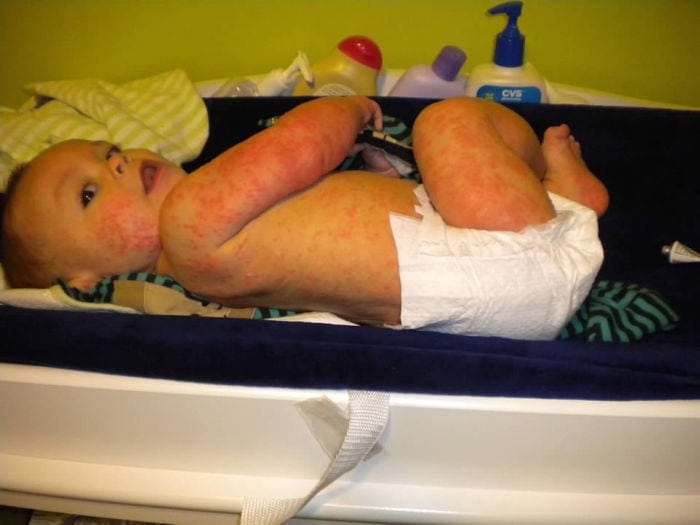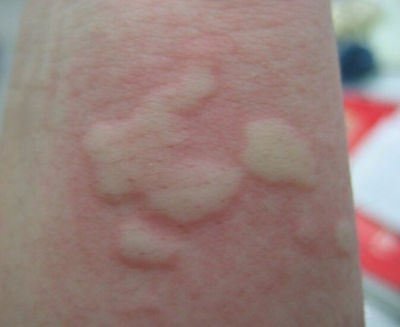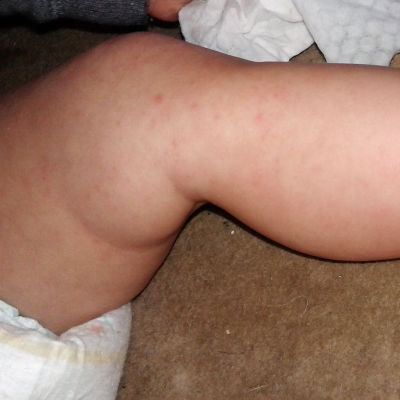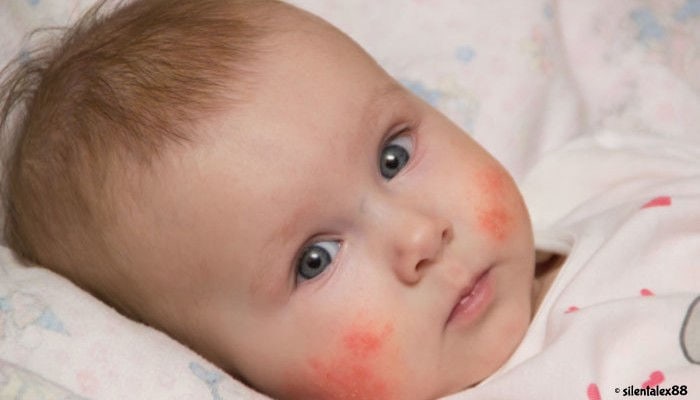By Jennifer Mearns, author of the blog The Undomestic Goddess
Picture this: My husband and I had survived the first four months with our first child. We were starting to breathe a little. The baby had survived thusly and was sleeping through the night. Then, all of a sudden, little dots started to appear on his skin. Slowly, the dots crept along his body, filling in the blanks until he looked like this:

I called the pediatrician several times, always assured by a nurse that newborn rashes can be normal. Not wanting to seem like an over anxious first-time parent, I didn’t take him in at first. He had no fever, but he looked like that!
Eventually, we took him in and got a diagnosis, which I’ll cover later. In an effort to make things a little easier for first time parents, I’ve compiled a list of common rashes, both benign and somet you should actually worry about.
First, I’ll cover the easy rashes.
Diaper Rash
Diaper rash is all too common and usually easily treatable. With a little diaper rash cream applied between every changing, most rashes of this sort will disappear. Diaper rash tends to get worse during teething and if the baby has had diarrhea.
Occasionally, diaper rash can get more severe and might require a doctor’s visit. If the baby is suffering from extreme redness and irritation with open sores, or it just won’t get better, it would be a good idea to have a doctor check it out. This rash can sometimes be caused by yeast and will require an antifungal cream to heal it.
Eczema
Eczema, or atopic dermatitis, is another very common rash that can show up on little guys. Many kids that suffer from eczema will grow out of it by the time they are two or three. Eczema can show up as dry, itchy patches on the skin. Some forms are mild and can be treated with lotion and fewer baths using soap, or even simply using an oatmeal soap. Some, however, need a thicker cream or even a steroid cream.
My firstborn isn’t so lucky. He still deals with severe eczema and is a very itchy guy. We try to lotion him every single night with heavy, thick cream lotion like Aveeno or Cetaphil. For a while we had the regular prescription 1% Hydrocortisone steroid cream and used that when his rash got extra bad. It didn’t always work though so our doctor prescribed something even stronger.
Eczema, while usually not harmful, can be a battle.
Now on to more serious rashes.
Allergic
If your baby breaks out in large raised but flat bumps (hives), this is likely caused by an allergic reaction. It could be caused by food, detergent, medication, or anything new to his system—which everything is because he’s a baby. It makes it super easy to figure out what he’s allergic to.
To make it even more confusing, sometimes allergies actually cause eczema. You might have to think about that if your baby is dealing with eczema. A simple antihistamine can help if your baby is over six-months, but check with your doctor first. Never give your baby any medication until you speak to a doctor.

Viral
When your baby gets a virus for the first time, while she’s still building her immune system, everything is—you guessed it—new! Sometimes viruses can cause rashes that are nothing to worry about, just a sign of the virus leaving her system. If your baby seems ok otherwise, the rash isn’t worsening or changing, this is likely what you are facing.

If the rash changes, becomes worse or is associated with a fever, you’ll need to check with your doctor as there are a number of viral rashes that are contagious and a few that are dangerous.
Coxsackievirus is a very common rash that causes hand, foot and mouth (HFM) disease. It shows up on the palms of the hands, soles of the feet and in the mouth. The rash can spread to the tops of the feet, backs of hands, outside of the mouth and sometimes on the bum. The bumps are small but can blister and be very painful. They may or may not run a fever and some kids are sicker than others with the virus. It’s also very contagious and spreads easily through schools and daycares.


Incidentally, this is the rash that my firstborn had at four months old, shown in the picture at the top of this post. Because he also had eczema, the virus was allowed a clear path to blanket his delicate skin in bumps.
Varicella virus in another viral rash you might encounter, commonly known as chicken pox. Most of us have had this virus and could spot the signs easily. But now that the vaccine is readily available, a lot of kids never get the virus. If your baby is exposed to the virus, the rash that appears will be itchy and raised. It will manifest with fever and cold or flu-like symptoms.
The worst of all the common viral rashes is herpes simplex virus. Because herpes has the capability of causing meningitis, it is critical for it to be diagnosed swiftly. A newborn or baby with eczema is particularly susceptible to this virus. Herpes will manifest as single vesicles on the skin or clusters of vesicles on the skin, and it may resemble other viral rashes.
If the rash is accompanied by fever and lethargy (listlessness, floppiness), it is essential that you consult your pediatrician immediately. Herpes can be spread from adults who have the virus and may not even be showing signs. A simple kiss from a person carrying the virus on a susceptible newborn can cause severe illness and even death. Babies are most susceptible in the first few months of life, before the vaccinations begin to work.
Sorry, this post got a little serious at the end here! The truth is, many infant rashes are harmless and easily treated, but it is good to be aware of the more serious rashes and illnesses your baby could potentially face. When my son broke out in that rash at four months, my doctor feared herpes could be the cause and treated him for it, despite the fact that it turned out to be Coxsackie virus.
Just remember, when in doubt call your pediatrician.
Want to see more blogs like this and get notifications on local events and happenings? Subscribe to our free weekly newsletters here.
















